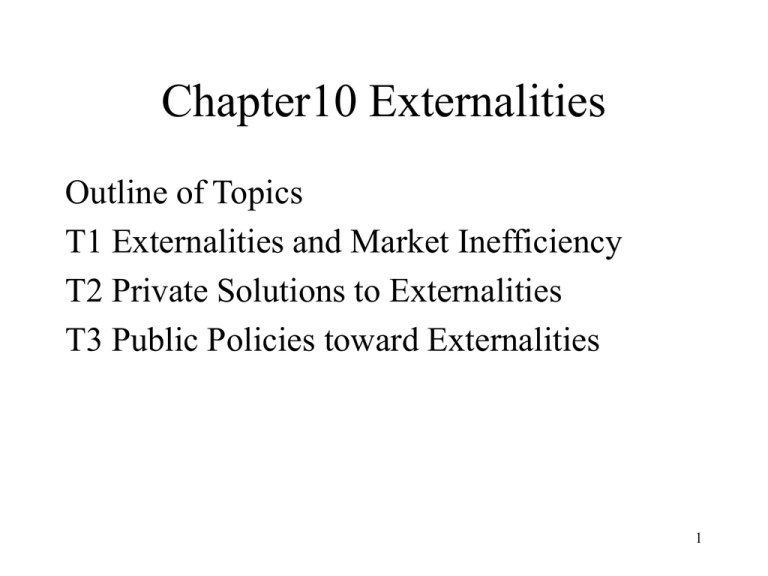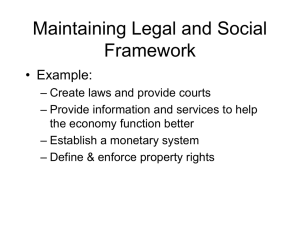Chapter10 Externalities
advertisement

Chapter10 Externalities Outline of Topics T1 Externalities and Market Inefficiency T2 Private Solutions to Externalities T3 Public Policies toward Externalities 1 • Markets do many things well, but they do not do everything well. Governments can sometimes improve market outcomes. • An externality arises when a person engages in an activity that influences the well-being of a bystander and yet neither pays nor receives any compensation for that effect. – Negative Externalities: if the impact on the bystander is adverse – Positive Externalities: if the impact on the bystander is beneficial T1 Externalities and Market inefficiency • Consider the market for aluminum. • See Figure 10-1 on page 207, a case without externalities. 2 • Now let’s suppose that aluminum factories emit pollution: for each unit of aluminum produced, a certain amount of smoke enters the atmosphere. It is a negative externalities because this smoke creates a health risk for those who breathe the air. • Because of this externality, the cost to society of producing aluminum is larger than the cost to the aluminum producers. • Consider what a benevolent social planner would do in this case. – The planner wants to maximize the total surplus derived from the market: the value to consumers of aluminum minus the cost of producing aluminum – The planner would choose the level of aluminum production at which the demand curve crosses the socialcost curve. 3 – See Figure 10-2 on page 208. – Note that the equilibrium quantity of aluminum, Qmarket is larger than the socially optimal quantity, Qoptimum. – The reason for this inefficiency is that the market equilibrium reflects only the private costs of production. – So, reducing aluminum production and consumption below the market equilibrium level raises total economic well-being. • Using the concept of deadweight loss to measure the value of this increase in economic well-being – Deadweight loss: the fall in total surplus that results from a market distortion, such as a negative externality – See Figure10-3 & Table 10-1 on page 210 – At market Equilibrium, (Pmarket, Qmarket) 4 • CS: A+B+C+D • The cost to society of producing the aluminum: F+G+B+C+ H • So, PS: E+F+G-(F+G+B+C+ H) E-(B+C+ H) • (In the presence of an externality, we use the social cost rather than using the private cost to sellers of producing aluminum to measure the producer surplus.) • So, total surplus, TS = CS+PS = A+B+C+D+ E-(B+C+ H) =A+D+E-H – At socially optimum (Poptimum, Qoptimum) • CS:D • PS:A+E 5 • TS= D+A+E • Deadweight Loss in Economic Welfare due to the negative externality – Triangle H is the deadweight loss to society, or reduction in total surplus, caused by the externality associated with producing aluminum. • Another way of understanding the nature of the market failure arising from an externality and determining the deadweight loss triangle si to consider the difference between the social cost curve and the demand curve for aluminum at the equilibrium level of production, Qmarket. – At Qmarket, the social cost curve lies above the demand curve. TS would therefore be higher if this last unit of aluminum was not produced at all. – The loss of TS of producing Qmarket rather than Qoptimum is equal to the area of the triangle formed by the social cost Curve and the demand curve between Qoptimum and 6 Qmarket. • How might a social planner achieve the socially optimal level of aluminum production and eliminate the deadweight loss associated with the externality? Taxes • The tax would shift the supply curve for aluminum up by the size of the tax. If the tax accurately reflects the social cost of pollution, the new supply curve coincide with the social-cost curve. • Such a tax is said to internalize the externality because it gives buyers and sellers in the market the incentive to take account of the external effects of their actions. • Taxes that internalize negative externalities are called Pigovian taxes. 7 • Positive Externalities in Production • Consider the market for robots. See Figure 10-4 on page 213. • Robots are at the frontier of a rapidly changing technology. Whenever a firm builds a robot, there is some chance that it will discover a new and better design. This new design will benefit not only this firm but also the society as a whole because the design will enter society’s pool of technological knowledge. This type of positive externality is called a technology spillover. • In the presence of a positive externality to production, the social cost of producing robots is less than the private cost. The optimal quantity of robots, Qoptimum is therefore larger than the equilibrium quantity, Qmarket- which generates a deadweight loss. 8 • Externalities in Consumption • The consumption of alcohol, for instance, yields negative externalities if consumers are more likely to drive under its influence and risk the lives of others. • The consumption of education yields positive externalities because a more educated population leads to better government, which benefits everyone. • See Figure 10-5 on page 215 • General lessons: – Negative externalities in production or consumption lead markets to produce a larger quantity than is socially desirable. – Positive externalities in production or consumption lead markets to produce a smaller quantity than is socially desirable. 9 – To remedy the problem, the government can internalize the externality by taxing goods that have negative externalities and subsidizing goods that have positive externalities. T2 Private Solutions to Externalities • Although externalities tend to cause markets to be inefficient, government action is not always need to solve the problem. In some circumstance, people can develop private solutions. For examples, sometimes, the problem of externalities is solved with moral codes, social sanctions and a contract. • The Coase Theorem – According to Coase theorem, if private parties can bargain without cost over the allocation of resources, then the private market will always solve the problem of externalities and allocate resources efficiently. 10 • See Dick and Jane’s case on page 216 & 217. • To sum up: The Coase theorem says that private economic actors can solve the problem of externalities among themselves. Whatever the initial distribution of rights, the interested parties can always reach a bargain in which everyone is better off and the outcome is efficient. • The Coase theorem applies only when the interested parties have no trouble reaching and enforcing an agreement. • In the real world, however, bargaining does not always work, even when a mutually beneficial agreement is possible. • Sometimes the interested parties fail to solve an externality problem because of transaction costs, the costs that parties incur in the process of agreeing to and following through 11 through on a bargain. T3 Public Policies toward Externalities • When an externality causes a market to reach an inefficient allocation of resources, the government can respond in one of two ways. – Command-and-control policies regulate behaviour directly – Market-based policies provide incentives so that private decision makers will choose to solve the problem on their own. • Example: Suppose that two factories- a paper mill and a steel mill-are each dumping 500 tonnes of glop into a river each year. – Regulation: Environment Canada could tell each factory to reduce its pollution to 300 tonnes of glop per year – Pigovian Tax: Environment Canada could levy a tax on 12 each factory of $50,000 for each tonne of glop it emits. • Most economists would prefer the tax. The reason why economists would prefer the tax is that it reduces pollution more efficiently. The regulation requires each factory to reduce pollution by the same amount, but an equal reduction is not necessarily the least expensive way to clean up the water. • In essence, the Pigovian tax places a price on the right to pollute. Just as markets allocate goods to those buyers who value them most highly, a Pigovian tax allocates pollution to those factories that face the highest cost of reducing it.. • Pigovian taxes correct incentives for the presence of externalities and thereby move the allocation of resources closer to the social optimum. Thus,while Pigovian taxes raise revenue for the government, they enhance economic 13 efficiency. • Tradable Pollution Permits • Consider our previous example of the paper mill and the steel mill. Suppose Environment Canada adopts the regulation and requires each factory to reduce it pollution to 300 tonnes of glop per year. Assume that the steel mill wants to increase its emission of glop by 100 tonnes. The paper mill has agreed to reduce its emission by the same amount if the steel mill pays it $5 million. • Should Environment Canada allow the two factories to make this deal? From the standpoint of economic efficiency, allowing the deal is good policy. • The deal must make the owners of the two factories better off because they are voluntarily agreeing on it. • Moreover, the deal does not have any external effects because the total amount of pollution remains the same. 14 • The same logic applies to any voluntary transfer of the right to pollute from one firm to another. • One advantage of allowing a market for pollution permits is that the initial allocation of pollution permits among firms does not matter from the standpoint of economic efficiency. – Those firms that can reduce pollution most easily would be willing to sell whatever permits they get, and those firms that can reduce pollution only at high cost would be willing to buy whatever permits they need. – As long as there is a free market for the pollution rights, the final allocation will be efficient whatever the initial allocation. • Although reducing pollution using pollution permits may seem quite different from using Pigovian taxes, in fact the two policies have much in common. 15 • In both cases, firms pay for their pollution. – With Pigovian taxes: polluting firm must pay a tax to the government. – With Pollution Permits: polluting firms must pay to buy the permit. – Both Pigovian taxes and pollution permit internalize the externality of pollution by making it costly for firms to pollute. • See Figure 10-6 on page 222. • In panel (a), the supply curve for pollution rights is perfectly elastic (because firms can pollute as much as they want by paying the tax), and the position of the demand curve determines the quantity of pollution. • In panel (b), Environment Canada sets a quantity of pollution by issuing pollution permits. The supply curve for 16 pollution right is perfectly inelastic ( because the Quantity of pollution is fixed by the number of permits) and the position of the demand curve determines the price of pollution. • Hence, for any given demand curve for pollution, Environment Canada can achieve any point on the demand curve either by setting a price with a Pigovian tax or by setting a quantity with pollution permits. • However, in some cases, selling pollution permits may be better than levying a Pigovian tax because the government does not know the demand curve for pollution. • Many environmentalists object to the use of pollution permits and other market-based solutions to pollutions on the grounds that it is simply not right to allow someone to pollute for a fee. Economists have little sympathy with this 17 type of argument because people face tradeoff.







